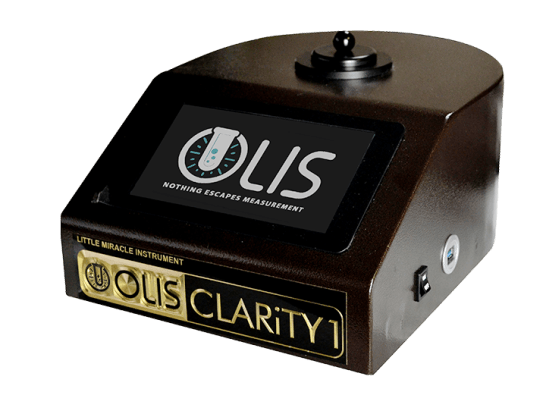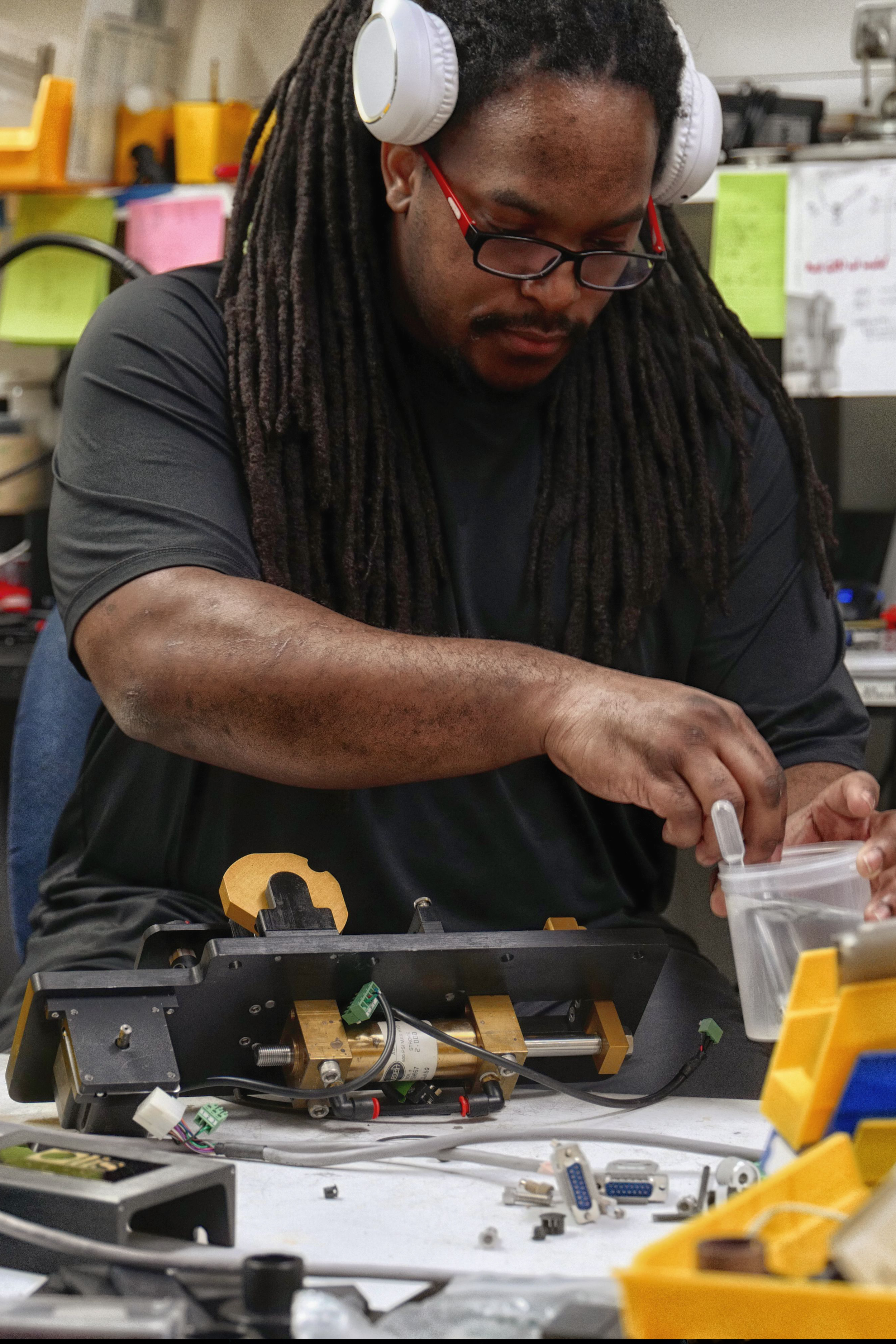Some Known Facts About Circular Dichroism.
Some Known Facts About Circular Dichroism.
Blog Article
All about Uv/vis
Table of ContentsCircularly Polarized Luminescence Can Be Fun For Anyone9 Simple Techniques For Circularly Polarized LuminescenceUv/vis - An OverviewThe 9-Minute Rule for Uv/visThe Definitive Guide to Uv/visNot known Details About Uv/vis The Main Principles Of Circularly Polarized Luminescence The Ultimate Guide To Uv/vis/nirRumored Buzz on Uv/vis/nirOur Circularly Polarized Luminescence PDFsNot known Facts About Circularly Polarized LuminescenceThe Best Guide To Uv/visUv/vis/nir - The Facts
It is then scanned through the sample and the referral options. Portions of the incident wavelengths are sent through, or shown from, the sample and the reference. Electronic circuits transform the relative currents into linear transmission percentages and/or absorbance/concentration worths.The transmission of a recommendation compound is set as a baseline (information) value, so the transmission of all other substances are taped relative to the preliminary "zeroed" compound. The spectrophotometer then converts the transmission ratio into 'absorbency', the concentration of particular parts of the test sample relative to the initial compound.
Considering that samples in these applications are not easily available in big quantities, they are especially fit to being evaluated in this non-destructive method. In addition, precious sample can be saved by using a micro-volume platform where as little as 1u, L of sample is required for complete analyses. A quick explanation of the treatment of spectrophotometry consists of comparing the absorbency of a blank sample that does not consist of a colored compound to a sample which contains a colored substance.
Top Guidelines Of Circularly Polarized Luminescence
In biochemical experiments, a chemical and/or physical property is selected and the treatment that is used specifies to that residential or commercial property in order to derive more information about the sample, such as the quantity, pureness, enzyme activity, and so on. Spectrophotometry can be used for a variety of methods such as figuring out ideal wavelength absorbance of samples, determining ideal p, H for absorbance of samples, determining concentrations of unknown samples, and determining the p, Ka of different samples.: 21119 Spectrophotometry is likewise a practical process for protein filtration and can likewise be utilized as a method to produce optical assays of a compound.
It is possible to understand the concentrations of a 2 component mixture using the absorption spectra of the standard solutions of each part. To do this, it is necessary to understand the extinction coefficient of this mixture at two wave lengths and the extinction coefficients of options which contain the known weights of the 2 parts.

The Basic Principles Of Circularly Polarized Luminescence
Region. The concentration of a protein can be approximated by measuring the OD at 280 nm due to the presence of tryptophan, tyrosine and phenylalanine.
Nucleic acid contamination can also interfere. This approach needs a spectrophotometer efficient in determining in the UV area with quartz cuvettes.: 135 Ultraviolet-visible (UV-vis) spectroscopy includes energy levels that thrill electronic shifts. Absorption of UV-vis light thrills molecules that remain in ground-states to their excited-states. Visible region 400700 nm spectrophotometry is utilized extensively in colorimetry science.
20. 8 O.D. Ink makers, printing companies, textiles suppliers, and a lot more, require the data provided through colorimetry. They take readings in the area of every 520 nanometers along the noticeable area, and produce a spectral reflectance curve or a data stream for alternative discussions. These curves can be utilized to test a brand-new batch of colorant to examine if it makes a match to requirements, e.
A Biased View of Uv/vis/nir
Traditional noticeable area spectrophotometers can not discover if a colorant or the base material has fluorescence. This can make it hard to handle color concerns if for example several of the printing inks is fluorescent. Where a colorant contains fluorescence, a bi-spectral fluorescent spectrophotometer is used (https://soundcloud.com/julieanndesalorenz30606). There are two significant setups for visual spectrum spectrophotometers, d/8 (spherical) and 0/45.
Researchers use this instrument to determine the quantity of compounds in a sample. In the case of printing measurements 2 alternative settings are frequently utilized- without/with uv filter to manage much better the impact of uv brighteners within the paper stock.
The Best Strategy To Use For Circular Dichroism
Some applications need little volume measurements which can be performed with micro-volume platforms. As described in the applications section, spectrophotometry can be used in both qualitative and quantitative analysis of DNA, RNA, and proteins. Qualitative analysis can be utilized and spectrophotometers are used to tape spectra of compounds by scanning broad wavelength regions to identify the absorbance properties (the intensity of the color) of the compound at each wavelength.

Spectrophotometers Fundamentals Explained
One major element is the kind of photosensors that are offered for different spectral regions, however infrared measurement is also tough due to the fact that virtually everything discharges IR as thermal radiation, especially at wavelengths beyond about 5 m. Another problem is that numerous materials such as glass and plastic soak up infrared, making it incompatible as an optical medium.
2013. p. 13. Allen, DW; Cooksey, C; Tsai, BK (Nov 13, 2009). "Spectrophotometry". Retrieved Dec 23, 2018. Ninfa AJ, Ballou DP, Benore M (2010 ). Basic Laboratory Methods for Biochemistry and Biotechnology (second ed.). Hoboken: Wiley & Sons. ISBN 9780470087664. OCLC 488246403. Schwedt G (1997 ). The vital guide to analytical chemistry.
Oke, J. B.; Gunn, J. E.
The Main Principles Of Circularly Polarized Luminescence

1021/ac50048a728. ISSN0003-2700. Ninfa AJ, Ballou DP, Benore M (2015 ). Fundamental Laboratory Methods for Biochemistry and Biotechnology (3, rev. ed.). Hoboken, NJ: Wiley & Sons. p. 77. ISBN9780470924525. OCLC915641828. "Totally Automatic Double Beam - Atomic Absorption Spectrophotometer (AA 8000)". Laboratory Equipment. Labindia Analytical Instruments Pvt. Ltd. "Spectrophotometry Applications and Basics".
Excitement About Spectrophotometers
"Applied Spectrophotometry: Analysis of a Biochemical Mix". Biochemistry and Molecular Biology check it out Education. Journal of Biochemistry Education.
The smart Trick of Uv/vis That Nobody is Discussing
U.S. Department of Commerce National Bureau of Standards unique publication; 378. Washington, D.C.: U.S. National Bureau of Standards.
The process starts with a controlled light that illuminates the examined sample. When it comes to reflection, as this light communicates with the sample, some is soaked up or released. The discharged light journeys to the detector, which is examined, measured, and provided as industry-standard color scales and indices.
All terms are evaluated over the visible spectrum from 400 to 700 nm. In the case of transmission, when the light communicates with the sample, it is either taken in, reflected, or transmitted.
The 15-Second Trick For Uv/vis
Examples consist of APHA (American Public Health Association) for watercolor and pureness analysis, ASTM D1500 for petrochemical color analysis, edible oil indices utilized in food, and color analyses of beverages. All terms are evaluated over the noticeable spectrum from 400 to 700 nm.
Image Credit: Matej Kastelic/ Dr. Arnold J. Beckman and his associates at the National Technologies Laboratories first invented the spectrophotometer in 1940. In 1935 Beckman founded the company, and the discovery of the spectrophotometer was their most ground-breaking development. Dr. Bruce Merrifield, a Nobel prize-winning biochemist, stated that the development of the spectrophotometer was "most likely the most crucial instrument ever established towards the improvement of bioscience." Before the discovery of the spectrophotometer, chemical analyses took weeks to complete, with 25% precision.
Rumored Buzz on Spectrophotometers
99% precision. Over time, scientists kept enhancing the spectrophotometer style to improve its efficiency. The UV capabilities of the model B spectrophotometer were enhanced by changing the glass prism with a quartz prism. Eventually, the Design DU was produced, including a hydrogen lamp and other enhancements. This instrument was utilized in commercial laboratories, clinics, and chemistry and biochemistry departments.
After 1984, double-beam versions of the device were developed. The addition of external software with the provision of onscreen screens of the spectra came in the 1990s. Typically, a spectrophotometer is comprised of 2 instruments, specifically, a spectrometer and a photometer. A basic spectrophotometer consists of a source of light, a monochromator, a collimator for straight beam transmission, a cuvette to put a sample, and a photoelectric detector.
Excitement About Uv/vis
There are different kinds of spectrophotometers in different sizes and shapes, each with its own function or functionality. A spectrophotometer determines just how much light is reflected by chemical components. UV/Vis/NIR. It determines the distinction in light intensity based upon the total quantity of light introduced to a sample and the amount of beam that goes through the sample option
Based on the instrument's design, the sample is placed between the spectrometer and the photometer. After the light is passed through the sample, the photometer measures its intensity and shows the reading. A spectrophotometer is utilized to determine the concentration of both colorless and colored solutes in a solution. This instrument is utilized to figure out the rate of a reaction.
Report this page